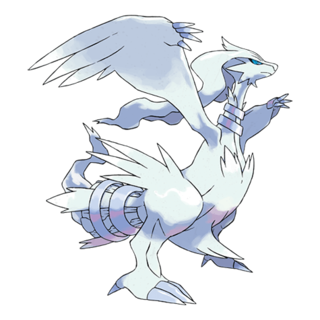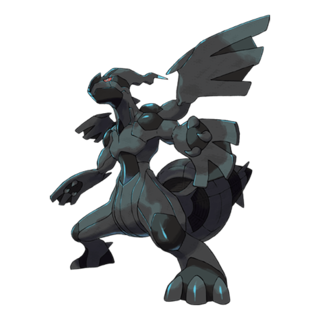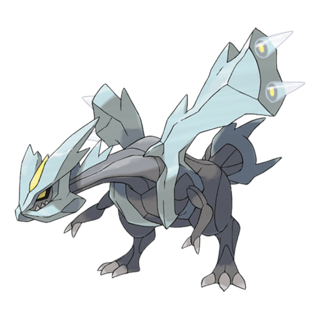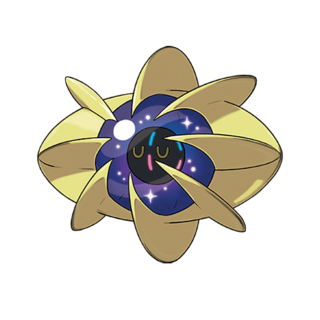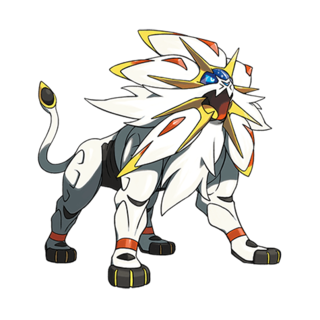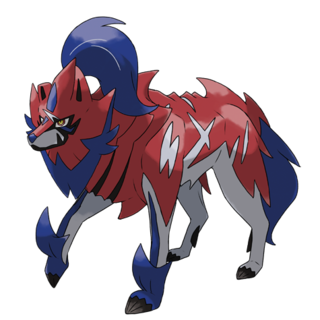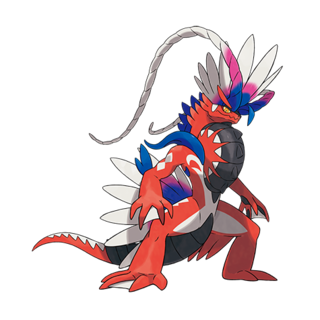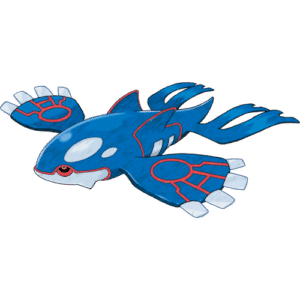Hello Trainers!
I’m back with another VGC format breakdown! At the start of May, official competitions and the in-game ladder switched to a new ruleset: Regulation G!
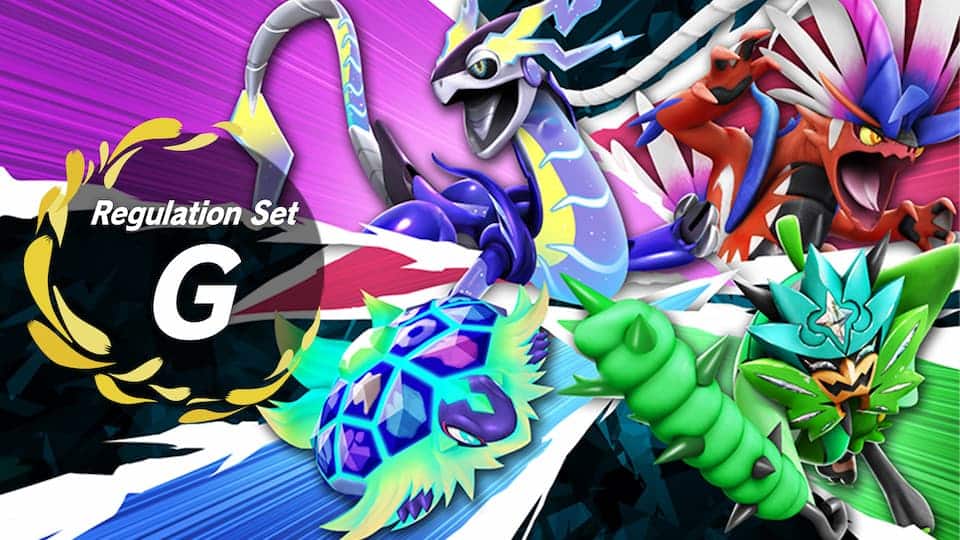
As you can probably tell from the official art for this format, this new ruleset brings about some exciting changes: for the first time in Scarlet and Violet, we are able to use some extremely powerful Legendary Pokémon in VGC!
For those of you that are unfamiliar with VGC, this may seem a bit confusing. Certain Legendary Pokémon, such as Cresselia, Ogerpon, and Tornadus to name a few, have been allowed for several formats so far, so what makes Regulation G special?
While there have been a plethora of Legendary Pokémon throughout the nine generations, certain Legendaries are considered more balanced than others, at least from a base-stat standpoint. This usually includes the Sub-Legendary groups such as the Kanto Birds, Johto Beasts, Unova Genies, etc. On the other hand, certain Legendaries fall under a subset that are known as Restricted Legendary Pokémon. These Legendaries reach power levels that surpass almost all other Pokémon, and as such are typically only allowed in certain formats, and even then only in limited quantities. The list of newly allowed Restricted Legendary Pokémon is as follows:
Plus Terapagos, who doesn’t yet have a page in our database, coming soon!
As you can see, the Restricted Legends title is mostly confined to the game mascots for each generation. It should be noted that the listed Pokémon above also include any alternate forms of fusions of said Legendaries, such as the alternate forms of the Sinnoh trio or the fused forms of Kyurem, Necrozma, and Calyrex.
Regulation G allows Trainers to include one Restricted Legendary Pokémon on their team for this ruleset. These Pokémon are exceedingly powerful and can shift the tide of battle in your favor, and as such, Trainers are all vying to find out which Legend is the most powerful and are building their teams around these powerhouses.
Just as with the first two entries in this series, my goal is to provide you with a rough overview of the current VGC format so that you can either begin competing for yourself, or so that you can get some insight into the meta as a spectator.
I think that about gets everything out of the way. With that being said, let’s dive in!
New Faces
While it may be a bit of a surprise to some, not all of the Restricted Legendary Pokémon are good, and some are actually borderline useless in VGC. For example, Mewtwo seems powerful on paper, but has pretty much never had any competitive viability. That isn’t to say that that these Pokémon can’t be used, but some are definitely better than others overall. With that being said, let’s take a look at the Restricted Legends that have been dominating the format so far!
Kyogre
Type: Water
Ability: Drizzle
Common Items: Mystic Water, Choice Scarf, Choice Specs, Leftovers
Common Moves: Origin Pulse, Water Spout, Hydro Pump, Ice Beam, Thunder, Calm Mind
Common Tera Type: Water, Grass
Kyogre has been and likely always will be a potent threat. Some Trainers may think that the loss of its Primal Reversion has slashed Kyogre’s viability, but in reality it is still just as powerful!
Kyogre’s primary claim to fame is its access to STAB Water Spout, a move that deals more damage the more HP the user has remaining. At full HP, it is a 150 base power attack that hits both opponents. On top of this, Kyogre always sets the Rain weather condition for itself thanks to its Ability Drizzle. This means that a standard Kyogre at full HP not only gets the STAB bonus on Water Spout, but also the 50% boost of Rain as well. Trainers will combo this with additional multipliers through Items like Mystic Water, other moves like Calm Mind, and the new addition of Terastalization with Tera Water.
There are certain methods to counter Kyogre that have become more and more popular, but Kyogre has adjusted. For example, if Kyogre takes too much damage, then Water Spout takes a significant damage decrease, but its signature move Origin Pulse is almost as powerful, albeit less accurate, but makes a nice addition as a plan B. Wide Guard is a move that works similarly to Protect, but only for moves that hit both targets. This completely negates both Water Spout and Origin Pulse, so some trainers prefer Hydro Pump as the backup Water move. Pokémon with Abilities that provide immunity to Water don’t love the idea of facing off against 100% accurate Thunder (thanks to the Rain) or Ice Beam.
The three sets that are seeing the most usage are the extremely fast and strong Choice Scarf/Specs sets, bulkier sets with Calm Mind and Leftovers and tera Grass for its defensive properties, or a mixed set with Mystic Water and that provides more flexibility. At the end of the day, Kyogre’s play style doesn’t change too much, but just because you know the tidal wave of Water Spout is coming doesn’t mean its easy to stop!
Groudon
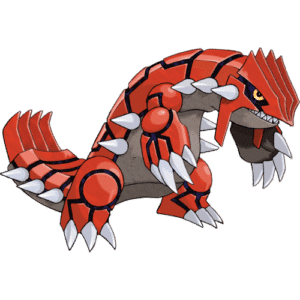
Type: Ground
Ability: Drought
Common Items: Clear Amulet, Assault Vest
Common Moves: Precipice Blades, Heat Crash, Swords Dance, Rock Slide, Heavy Slam
Common Tera Type: Fire, Water, Grass
Kyogre’s counterpart is having just a big of an impact on this format, albeit in a much different way. Groudon was immediately considered as a powerful contender long before it was legal in VGC. This is due to the Paradox Pokémon that were introduced in Scarlet and Violet, namely the Ancient Paradox Pokémon. These Pokémon have the ability Protosynthesis, which gives them a stat boost when activated. Protosynthesis activates in Harsh Sunlight, which is automatically set by Groudon’s Drought Ability. This gives Groudon the ability to passively support other members of the team while also being a potent threat itself.
Groudon is a bit interesting in that, unlike Kyogre, its passive weather condition does not power up its primary STAB moves, being its Ground type moves. However, it does in practice give it an additional STAB type offensively while also negating one of its weaknesses to Water. This pairs extremely well with a tera type of Fire, which adds damage output to its Fire moves in the Harsh Sunlight while also negating some of its weaknesses. However, this is extremely dependent on Groudon being able to maintain the Harsh Sunlight. Without the right weather, Tera Fire Groudon becomes extremely vulnerable.
The most common set on Groudon right now utilizes the Clear Amulet item to prevent stat drops and provide an immunity to Intimidate. This pairs nicely with Swords Dance, which gives Groudon an Attack boost that can’t easily be removed. Precipice Blades is an essential, with Fire coverage and Protect rounding out the moveset. However, a more defensive set with the Assault Vest has also seen some play, with amazing coverage options like Rock Slide and Heavy Slam replacing the status moves. This helps to ensure that the entire team relies on Groudon surviving. It is on these sets where you will likely find a Tera type other than Fire.
Groudon’s ability to passively set up Harsh Sunlight did not immediately make it the overwhelming threat that Trainers had initially predicted. Relying on an 85% accurate move as its most consistent offensive option is inherently risky. However, the remaining tools in its kit have helped it solidify its position as a mainstay in the current format. If you’re facing off against this monster, be ready for a weather war!
Rayquaza
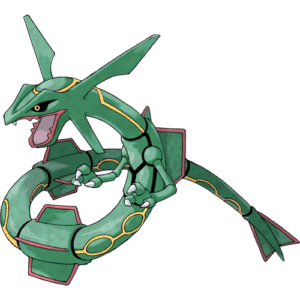
Type: Dragon /
Ability: Air Lock
Common Items: Clear Amulet
Common Moves: Dragon Ascent, Extreme Speed, Swords Dance
Common Tera Type: Normal
While Kyogre and Groudon have been consistently powerful options in VGC whenever they are legal, Rayquaza has seen almost no play outside of formats where its Mega Evolution is legal. However, it is seeming some serious play for the first time in Scarlet and Violet!
Let’s start with its Ability. Air Lock negates the effects of all four weather conditions (but does not get rid of the weather). This includes the damage bonuses/reductions, as well as any passive effects from moves/Abilities. This has always been an extremely powerful effect, but it is made even more powerful thanks to its interaction with Protosynthesis. If the Ancient Paradox Pokémon’s Protosynthesis activated thanks to Harsh Sunlight, then Rayquaza switching in will deactivate the Ability. It is important to not that if the boost was activated by the Booster Energy Item, then the boost will remain, and Booster Energy will still activate Protosynthesis even if Air Lock is in effect. However, this is still just another added layer of utility for Rayquaza!
Rayquaza plays very similarly to the original Extreme Speed Dragonite set. However, there are some differences. Firstly, Dragonite has the Ability Inner Focus, which makes it immune to both flinching as well as Intimidate. This allows Dragonite to hold an Item to boost its damage output, usually the Choice Band. Rayquaza is usually forced to run the Clear Amulet Item to prevent its stats from being dropped. This means that it doesn’t have the immediate damage output that Dragonite has. However, it makes up for this with the flexibility this set allows for. It doesn’t get walled by anything that resists Extreme Speed, with Dragon Ascent being a powerful nuke option. It can also boost its damage output with Swords Dance, which again can’t be easily removed thanks to its Clear Amulet, and also has the option to Protect unlike Dragonite. Overall I think that Rayquaza is slightly less consistent than Dragonite, but more more flexible. It may be a bit harder to learn how to use, but it will likely be easier to play in different situations than with Dragonite, which is extremely predictable.
I think many veteran VGC Trainers never saw a world in which Dragonite and Rayquaza were competing with each other, yet here we are! Rayquaza is far from dominating Regulation G, but it is much stronger and more consistent than it has ever been before. Personally, I’m happy to be running into more than a few Rayquaza on the in-game ladder!
Lunala
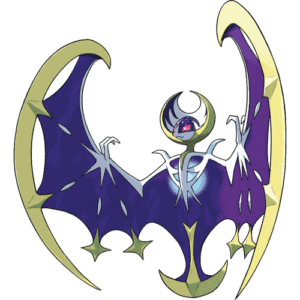
Type: Psychic / Ghost
Ability: Shadow Shield
Common Items: Power Herb
Common Moves: Moongeist Beam, Meteor Beam, Moonblast, Expanding Force, Trick Room, Wide Guard
Common Tera Type: Fairy, Dark
Lunala may seem like an interesting pick, especially since its fusion form with Necrozma, Dawn Wings Necrozma, its notably absent. However, I’m getting ahead of myself again.
The mascot of Sun and Moon has a lot of interesting tools at its disposal, but we’ll start with some of its base attributes. Lunala’s typing is interesting in that it only is weak to two types, being Ghost and Dark, but it is 4x weak to both. This pairs very nicely with its Ability Shadow Shield. This works similar to Dragonite’s Multiscale in that it reduces any incoming damage by 50% if the user is at full HP. Seeing as Lunala takes neutral damage from the majority of incoming attacks, it is near guaranteed to live at least one hit.
Lunala sees the most usage as a Trick Room setter/sweeper, with some built in utility tools as well. This is helpful in that you don’t need to rely on a 2-Pokémon lead in order to set Trick Room. This is also pretty reliable, as The combination of Meteor Beam and Power Herb can give Lunala a +1 in Special Attack while also dealing significant damage. Its signature move Moongeist Beam is a no-drawbacks Ghost move that can ignore the Abilities of its targets. If it is going to run Psychic STAB, then it will run Expanding Force, but this requires additional support to get maximum effectiveness and is not a very popular option. While Tera Dark is nice to shut down both of its weaknesses as well as to provide an immunity to Prankster Taunt to shut down Trick Room, many Trainers choose to run Moonblast in the fourth slot, which pairs nicely with Tera Fairy. However, there is another option for the fourth move that ends up providing much more support for the battle: Wide Guard.
I talked about this briefly in Kyogre’s section, but Wide Guard is an extremely valuable move in Restricted Legendary formats. As mentioned, Wide Guard protects both the user and its partner from moves that would have hit multiple targets, so moves such as Earthquake and Heat Wave will be blocked by a single move. While Wide Guard has had some niche usage throughout Scarlet and Violet, it is especially important in Regulation G. Many of the Restricted Legendaries have extremely powerful spread moves that can tear through your team, but Wide Guard completely shuts them down. Groudon’s Precipice Blades, Kyogre’s Origin Pulse and Water Spout, and several other powerful moves are key components of many teams’ strategies, so Wide Guard is more prevalent than ever.
Sorry for the side tangent, but TLDR: Wide Guard is very useful, and you’re almost never mad to have it on Lunala. The combination of Shadow Shield and Wide Guard are the reasons that Lunala is usually preferred over Dawn Wings Necrozma. Lunala is extremely difficult to get off the field, and can simultaneously act as an offensive threat as well as a support Pokémon. While it may not be the most common pick, Lunala is a threat to be sure!
Zacian
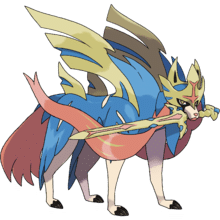
Type: Fairy / Steel
Ability: Intrepid Sword
Common Items: Rusted Sword
Common Moves: Behemoth Blade, Play Rough, Sacred Sword, Swords Dance, Substitute
Common Tera Type: Water, Stellar
Zacian is the monster that dominated VGC for the entirety of Sword and Shield. It has the best type combination of the game, a broken Ability, and access to every move it could ever want. It was so powerful that both its base stats as well as its Ability were nerfed going into Scarlet and Violet, but once again I’m jumping ahead a bit.
Zacian in its base form is a pure Fairy type. In order to utilize its Crowned form and gain the secondary Steel typing, it must be holding its signature Rusted Sword Item, taking up the Item slot. Prior to Scarlet and Violet there were some cases where you would use its base form without the Rusted Sword, but thanks to the nerfs there is pretty much no reason not to use the Crowned form. Taking away its Item slot is one of the only “balancing factors” that Zacian has to contend with, but even considering that this thing is a monster.
Zacian’s Ability, Intrepid Sword, gives it a +1 boost in its Attack stat upon switching in. Prior to Generation 9, this would activate every time Zacian switched in, meaning it was essentially always at +1 Attack. It was nerfed to only activate a single time per battle now, meaning you have to be much more thoughtful about when you choose to use it. It is a pure offensive threat through and through, with STAB moves Behemoth Blade and Play Rough tearing through teams. It makes great use of the Stellar Tera Type, with Sacred Sword as a great coverage option, but it can also make use of a defensive Water Tera type with Substitute and Swords Dance to bolster both its offensive and defensive prowess.
Zacian is no longer the monster it was in Sword and Shield, but it is far from washed. This thing will tear holes in your team if positioned correctly, and it should never be underestimated!
Zamazenta
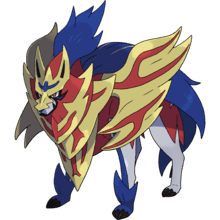
Type: Fighting / Steel
Ability: Dauntless Shield
Common Items: Rusted Shield
Common Moves: Behemoth Bash, Body Press, Iron Defense, Wide Guard, Heavy Slam
Common Tera Type: Water, Grass, Ghost
This was a surprise for everyone to be sure. Zamazenta was the laughingstock of Generation 8, as it paled in comparison to its sword-wielding counterpart. On top of that, Zamazenta was nerfed alongside Zacian despite definitely not needing it as badly. Zamazenta’s stat nerf was less impactful, as it lost 10 points in Attack as well as 5 in both Defense and Special Defense compared to Zacian losing all 20 in Attack. The Dauntless Shield nerf isn’t as impactful based on Zamazenta’s play style, but is a meaningful nerf nonetheless.
While Zamazenta definitely caught some unnecessary flak as a result of being Zacian’s counterpart, it did get one meaningful buff going into Scarlet and Violet: it got access to Body Press. For those unfamiliar, this is a Fighting type move that calculates damage using the Defense stat rather than Attack. Zamazenta believers were begging for this move to be added to its kit, and Game Freak delivered. Its a powerful option on defensive Pokémon to have solid field presence, and it allows a Pokémon to simultaneously boost its defensive and offensive prowess by boosting a single stat!
Zamazenta is built to sit on the field for as long as possible. With Iron Defense, it can reach 2.5x its base Defense stat in a single move, leaving not many Pokémon that can take a hit from STAB Body Press. Behemoth Bash is the most consistent of its Steel STAB options, but a solid case can be made for Heavy Slam. Additionally, it is a great user of Wide Guard, which can protect it from some of the most powerful Ground type moves like Earthquake and Precipice Blades that may be sent its way. Its Tera type will change based on what your team lacks defensive tools against. Water is the most popular, as it provides the best defensive profile against Ursifu’s Surging Strikes, one of the best tools to counter Zamazenta. However, its other two options have great properties as well, with Grass turning its Ground weakness into a resistance and providing an immunity to Spore and Rage Powder, and Ghost turning its weakness to Fighting into an immunity as well as providing an immunity to Fake Out.
Zamazenta is a legitimate threat for the first time in Regulation G. I have played plenty of matches where my team simply could not remove Zamazenta from the field. I personally am happy for the Zamazenta believers, as it has surpassed Zacian in usage stats for the first time ever! Don’t underestimate the shield doggo!
Calyrex (Ice Rider)
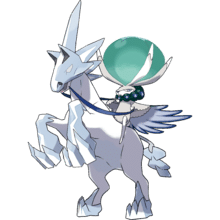
Type: Psychic / Ice
Ability: As One (Unnerve/Chilling Neigh)
Common Items: Clear Amulet, Weakness Policy, Assault Vest
Common Moves: Glacial Lance, High Horsepower, Trick Room
Common Tera Type: Water, Fire
First off, a brief note about Calyrex.
Calyrex is one of the aforementioned Restricted Legendary Pokémon that has multiple different forms via fusing with other Pokémon, in this case Glastrier or Spectrier (who have been legal since Regulation D). Calyrex in its base form is a Psychic / Grass type, but don’t expect to see this form anywhere, as it is largely useless. However, its fusion forms more than make up for it.
Calyrex Ice Rider is the fused form of Calyrex and Glastrier, and this thing is an absolute menace. It takes the best attributes of Glastrier, which is already a powerful Pokémon on its own, and takes it to an absurdly broken level. To demonstrate this, let’s take a look at its Ability. As One allows Calyrex-Ice (I’ll refer to it as this from now on) to utilize both Abilities from Calyrex and Glastrier, respectably. Calyrex’s Unnerve stops opponents from eating berries, which can be key components of a Pokémon’s survivability, and Glastrier’s Chilling Neigh gives the user an Attack boost for every KO it takes. These Abilities are both powerful on their own, but having one Pokémon able to use both is kind of ridiculous.
Calyrex-Ice, just like Glastrier, is built to be a physical Trick Room sweeper. It has all the base stats it could ever want in every category that matters. On top of this, the added Psychic moves added to its movepool thanks to Calyrex allow it to set Trick Room for itself. This combination on its own would be powerful enough, but on top of this, its gets a new signature move called Glacial Lance. This is an extremely powerful, zero drawback Ice move that hits both opponents. As a reminder, Calyrex-Ice gets an Attack boost for each KO that it takes, and being able to hit around redirection moves like Follow Me or Rage Powder means that it can easily pick off weakened opponents and gain an instant buff. While there are a variety of Items that Calyrex-Ice can make great use of, such as Weakness Policy or Assault Vest, the Clear Amulet is largely considered to be the best option, providing an immunity to Intimidate and making it extremely difficult to remove any Chilling Neigh buffs. High Horsepower provides great coverage, and Ice / Ground as an offensive pairing is difficult to beat. Finally, for Tera typing, I personally find myself running into more Tera Fire Calyrex, as it shuts down a lot of its weaknesses and makes it immune to being Burned, but Tera Water can wall out certain other prominent threats. To be completely honest, you can’t go wrong with either.
Calyrex-Ice is arguably the strongest Restricted Legendary Pokémon in the format right now. Players are constantly adding tools to their team in order to be able to counter it, yet it its still the most popular Restricted Legend in usage stats. Just know that if this thing ends up on the field in Trick Room, there isn’t much you can do to stop it from steamrolling your team.
Calyrex (Shadow Rider)
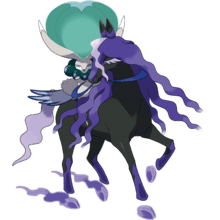
Type: Psychic / Ghost
Ability: As One (Unnerve/Grim Neigh)
Common Items: Focus Sash, Life Orb, Choice Specs
Common Moves: Astral Barrage, Draining Kiss, Expanding Force, Tera Blast, Nasty Plot
Common Tera Type: Fairy, Ghost, Fighting
Calyrex’s Shadow Rider form is just as powerful as its Ice Rider form, and it could be argued that it is better in some cases. They are counterparts in every sense of the word, with Calyrex-Ice being a slow, physical attacker and Calyrex-Shadow being a blazing fast special attacker. Spectrier’s Ability, Grim Neigh, is similarly a counterpart in that it boosts the user’s Special Attack with every KO taken instead. While Calyrex-Shadow’s offensive coverage with dual Ghost and Psychic STAB isn’t as threatening on its own compared to Calyrex-Ice and its coverage, it is slightly better defensively, providing two immunities. It is also better able to take advantage of its Psychic type offensively.
Calyrex-Shadow requires a lot less setup than its icy counterpart in order to be a threat, being able to immediately threaten damage with its signature move Astral Barrage, a Special Ghost type move that hits both targets. However, with some setup it can become even more threatening. If it finds itself on the field with Psychic Terrain active, then it becomes a great user of Expanding Force to threaten anything that Astral Barrage might not be able to handle. Draining Kiss has become a near staple on all Calyrex-Shadows, as it is able to provide some great coverage and recovery even despite its low base power thanks to Calyrex-Shadow’s sky high Special Attack.
Calyrex-Shadow’s choice of Item and Tera type go hand in hand. With the Choice Specs, it can tear holes in opposing teams right off the bat, especially given its great coverage. However, it is extremely frail and vulnerable to Ghost and Dark moves, so Focus Sash is preferred by many players. This also has the benefit of potentially letting Calyrex set up with a Nasty Plot, which is scary to even think about. A nice balance between the two is the Life Orb, which boosts damage output at the cost of some HP. This works because realistically, if Calyrex is taking a strong attack then it is going down anyway, and it can heal off the Life Orb recoil with Draining Kiss. On the hyper-offense sets, Tera Ghost can help ensure that it can take a KO early so that it can snowball thanks to Grin Neigh, but Tera Fairy pairs nicely with Draining Kiss and can turn its 4x weakness to Dark into a resistance. Tera Fighting is a more niche pick, but it similarly turns its Dark weakness into a resistance and can hit Incineroar with a Super-Effective Tera Blast. At the end of the day, any set that Calyrex-Shadow runs is going to be trouble to deal with, and you never know which one you’re going to be facing off against.
The duo of Calyrex’s fusion forms are currently the two most popular Restricted Legendary Pokémon in the format, and for good reason. The honestly don’t require too much skill to perform well, yet a smart Trainer can make their team near unbeatable. Trainers have been scrambling to find counterplay against these two stupid horses since Regulation G was announced!
Koraidon
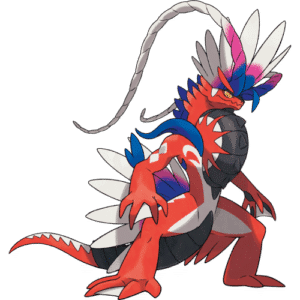
Type: Fighting / Dragon
Ability: Orichalcum Pulse
Common Items: Clear Amulet, Life Orb, Assault Vest, Choice Band
Common Moves: Collision Course, Flare Blitz, Dragon Claw, U-Turn, Flame Charge, Scale Shot, Swords Dance
Common Tera Type: Fire
And now we’ve reached the first of our entries featuring one of the Legendary Pokémon making its VGC debut with Koraidon, the mascot of Pokémon Scarlet! Koraidon and Miraidon had both been a bit of a mystery for players, as their power level was extremely unpredictable but was bound to be powerful. This is due to the way they interact with their fellow Paradox Pokémon. I’ll explain it more thoroughly with Koraidon, but know that much of the same applies to Miraidon as well.
Koraidon’s Ability, Orichalcum Pulse, is kind of two Abilities in one. Kind of. Let me explain. First off, it summons the Harsh Sunlight weather condition when switched in, operating the exact same as the Ability Drought. However, in addition to setting the weather, Orichalcum Pulse also gives Koraidon a 33% boost to its Attack stat, similar to the boost given by Protosynthesis. Unlike Protosynthesis, however, this boost can only be given to Attack and not to any other stat.
Koraidon functions as a sweeper that can also provide passive benefits to its team. It pretty much always runs Flare Blitz, similarly to how Groudon always runs a Fire move. It is powerful enough with the Harsh Sunlight boost, but combined with Tera Fire it can be even more threatening. Tera Fire also provides nice defensive utility, turning its 4x weakness to Fairy into a resistance. The rest of its moves depend on what type of set you are running, although all of its sets are offense oriented. Its signature move Collision Course is a staple, being a powerful no-drawbacks Fighting move. The most consistent set utilizes Clear Amulet to block Intimidate, with the boost from Orichalcum Pulse being more than enough to dish out damage. While it can boost its Attack further with Swords Dance, this usually isn’t necessary. Life Orb or Choice Band are much more viable ways to boost damage, with Dragon Claw and U-Turn making nice options to round out the moveset. If you are looking to boost its Speed to turn it into an even more threatening sweeper, then Flame Charge or Scale Shot are nice alternatives as well.
Koraidon is a solid all-rounder, but it is its ability to power up other teammates such as Walking Wake, Raging Bolt, Flutter Mane, and more that make it so valuable. Overall, the Ancient Paradox Pokémon have proven to be much more viable in VGC, so Koraidon is a naturally powerful pick. It is the new premiere sun setter in the current meta!
Miraidon
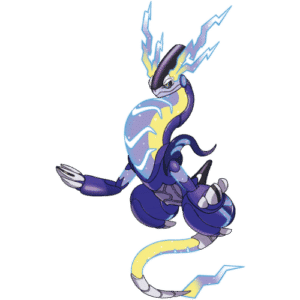
Type: Electric / Dragon
Ability: Hadron Engine
Common Items: Choice Specs, Life Orb, Assault Vest
Common Moves: Electro Drift, Draco Meteor, Volt Switch, Dazzling Gleam, Dragon Pulse, Parabolic Charge, Calm Mind
Common Tera Type: Electric, Fairy
The Violet counterpart of the Paradox Duo is Miraidon. It operates in a similar manner to Koraidon, operating as an offensive threat on its own with the bonus benefit of passively supporting its team. Whether or not this passive support is helpful is up for debate, but I’m once again getting ahead of myself.
Miraidon’s Ability, Hadron Engine, sets Electric Terrain on the field while also providing Miraidon with a 33% boost to its Special Attack. This allows Miraidon to fill an interesting niche. The only two Pokémon with the Ability Electric Surge, which sets Electric Terrain on switch in, are Tapu Koko and Pincurchin, both of which are not legal in Scarlet and Violet. As such, it has been very difficult to passively activate the Quark Drive Ability of the Future Paradox Pokémon, as compared to being able to passively set the Harsh Sunlight to activate the Protosynthesis of the Ancient Paradox Pokémon. Miraidon opens some interesting doorways for teambuilding, especially with Pokémon that were strong even without Quark Drive such as Iron Bundle and Iron Hands. On top of that, Electric Terrain also boosts the damage of Miraidon’s STAB Electric moves, a benefit that Koraidon does not share without Terastalization.
As mentioned previously, Miraidon operates in a similar manner to Koraidon, albeit slightly different. As a Special Attacker, it doesn’t need to worry about Intimidate and has access to much better tools to utilize its Dragon STAB, with Draco Meteor as a powerful nuke option but Dragon Pulse being more consistent. It also has access to a plethora of powerful Electric moves that benefit both from STAB as well as the Electric Terrain. Its signature move, Electro Drift, is a must-have, but the other options differ based on the build. On a Choice Specs or Assault Vest set, it will usually opt for Volt Switch as a powerful pivot option. However, on the Life Orb Calm Mind set that has seen some play it will usually run Parabolic Charge for a recovery option. Most are opting for Tera Electric to maximize its damage output, but Tera Fairy is a nice defensive option that pairs well with Dazzling Gleam on an Assault Vest set.
Miraidon was being widely tested at the start of Regulation G, and many Trainers wrote it off as overrated. However, it won the first major tournament of Regulation G, demonstrating its prowess. I think its safe to say we haven’t unlocked the full potential of Miraidon yet, but it sure to be a powerhouse no matter what!
Terapagos
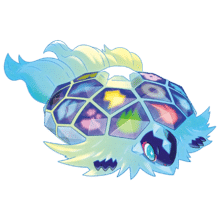
Type: Normal
Ability: Tera Shell/Teraform Zero
Common Items: Leftovers, Power Herb, Choice Specs
Common Moves: Tera Starstorm, Earth Power, Meteor Beam, Dark Pulse, Hyper Beam, Calm Mind
Common Tera Type: Stellar
Terapagos is by far one of the most complex Pokémon on this list, but it is easily one of the most powerful! I will do my best to break down the way it works, but it is more than a bit confusing. Terapagos’s base form has the Ability Tera Shift, which transforms it into what is called its Terastal Form. This form gains its own base stat total and Ability. To make things even more confusing, Terapagos can then Terastalize when in this form, which transforms it again, this time into its Stellar Form. This Stellar Form also has its own base stats and Ability. One thing that makes things slightly less confusing is that you basically never have to worrk about its Base Form, which will literally never be used in battle, but learning how to juggle its Terastal Form and its Stellar Form is definitely challenging.
Unlike the rest of this list, I think its important to start by explaining Terapagos’s Tera type. Terapagos can only ever utilize the Stellar Tera type. While this makes Terapagos extremely predictable, it does come with one benefit. Its signature move, Tera Starstorm, operates similarly to Tera Blast in that it is a Normal type move before Terastalizing and a Stellar type move after. This is extremely powerful, as no Pokémon in the game can resist a Stellar type move, and it is Super-Effective against opposing Terastalized Pokémon. However, Tera Blast has the downside of lowering the user’s offensive stats whenever it is used. Not only does Tera Starstorm not have that downside, but it also hits both targets whenever Terapagos is Terastalized (say that five times fast!) As mentioned previously, Terapagos teams are pretty predictable, but that isn’t a problem, as there isn’t much you can do to switch in on a Tera Startstorm!
Let’s now talk a bit about Terapagos’s Ability (or rather Abilities). In its Terastal Form, its Ability is Tera Shell. This Ability causes any move targeting Terapagos while it is at full HP to deal Not Very Effective damage. This is extremely useful, as it basically ensures that Terapagos will live any one attack, allowing it to effectively set up or fire off a free attack. Once it Terastalizes, it gains the Ability Teraform Zero. This Ability clears all weather and terrain effects from the field instantly, but can only activate once per battle. However, it is extremely powerful because this effect activates upon Terastalizing, meaning it will activate after switch ins and Ability activations, which will overwrite any weather or terrain set by a switch in.
Terapagos’s most common set is as a bulky setup sweeper. It utilizes its Ability with the Item Leftovers to set up with Calm Mind in its Terastal Form before Terastalizing and sweeping in its Stellar Form. Protect is essential to get multiple uses out of Tera Shell, and Earth Power rounds out its moveset nicely to deal Super Effective damage against many of the meta’s top threats. Some other sets have been rising in popularity, however. A Power Herb and Meteor Beam set provides immediate field presence and damage output, whereas a Choice Specs takes out the hassle of having to set up. Certain moves, such as Dark Pulse and Hyper Beam, allow Terapagos to have some field presence in its Terastal Form. While this makes your team less predictable, it does limit the offensive prowess of Terapagos, as you are missing the bonus stats from its Stellar Form.
Terapagos is still one of the biggest wild cards in Regulation G. It has such a unique play style, and we are still seeing new ways of using it to this day. All I know is that I’m happy that this little guy turned out to be good, and its fun to see it facing down the likes of Calyrex and Kyogre on the battlefield!
I think this takes the cake for the longest section ever in this series. Sorry for rambling, but seeing as this ruleset is based around these powerful Legendary Pokémon, its important that we’re familiar with them.
With that being said, let’s take a look at some returning favorites!
Returning Favorites
Incineroar
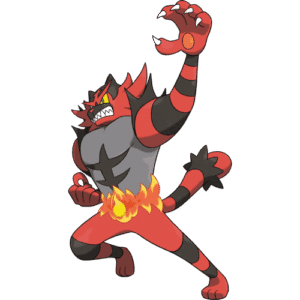
Yep, Incineroar is still doing Incineroar things. It didn’t receive anything new, but it has such a diverse set of tools that it can survive and thrive in any meta. Unfortunately this thing isn’t going anywhere anytime soon.
Rillaboom
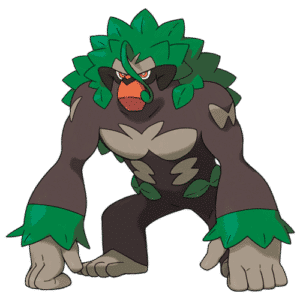
Rillaboom is still just as consistent as ever. It also has everything it could ever want, from great offensive tools to extremely useful utility. It also has the benefit of being only one of the only three terrain setters that are legal, meaning it provides unique utility that is extremely valuable to your team.
Tornadus (Incarnate)
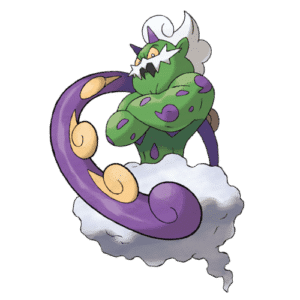
This thing is still the premiere Tailwind setter. Running weather moves to overwrite unfavorable weather has become more common to deal with the rise of Groudon, Kyogre, and Koraidon. Bleakwind Storm is still an absurdly powerful move for a largely supportive Pokémon to have. I think its safe to say this thing has taken the crown from Landorus as king of the genies!
Urshifu (Rapid Strikes)
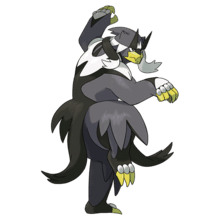
Funny bear still hits through Protect. Yes, its still broken. It is one of the only consistent counters to Zamazenta, and it gets even more powerful when paired with Kyogre. At least those who paid for their funny Legendary are getting their money’s worth…
Amoongus
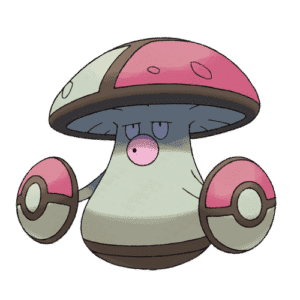
Spore and redirection support are still just as valuable as ever. Clear Smog has become more popular to get rid of any stat buffs that the powerful Legendaries may have, and Pollen Puff is still amazing support. Be prepared to have some type of switch-in for Spore on your team!
Ogerpon (Wellspring Mask)
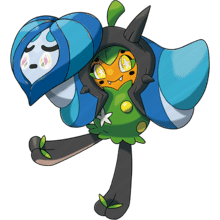
Ogerpon still provides an amazing level of support for your team, as well as solid damage output. It is still the best redirector in the format, and it fits well on most team archetypes. It is one of the best counters to Kyogre, so you’ll never be upset to have it on a team.
Raging Bolt
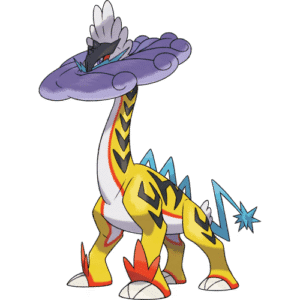
Raging Bolt is just as effective as ever, and it gets a nice boost when paired with Groudon or Koraidon. It is also an amazing counter to Kyogre, and with Snarl as coverage it does extremely well against many of the top threats. It’s funny that this funny looking giraffe has become such a VGC threat!
Farigiraf

The ability to block priority moves is still extremely valuable. While most of the Restricted Legendary Pokémon aren’t using priority moves, the moves that Farigiraf was already good at blocking are just as prominent in this Regulation, if not more so. Add on its effectiveness in Trick Room, and you’ve got an extremely powerful Pokémon!
Chi-Yu
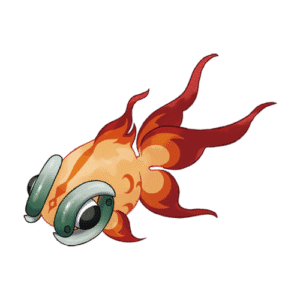
Chi-Yu’s Beads of Ruin Ability is still just as powerful as ever. Pair it with powerful special attacking Restricted Legends such as Calyrex-Shadow, Kyogre, or Terapagos, and there’s not much that will survive a hit.
Chien-Pao

Same thing as Chi-Yu, but for physical attackers. It’s best buddies with the likes of Groudon and Kyogre and even has utility paired with some others. Not many things like taking a Sword of Ruin boosted Sucker Punch from this thing.
Ursaluna (Bloodmoon)
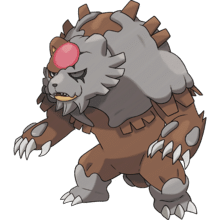
Bloodmoon Ursaluna seems to have taken the spotlight from its Hisuian cousin for the more popular form. Interestingly, Trainers are starting to run Ursaluna outside of Trick Room, and it is still proving itself a threat.
Taking the Spotlight
Mienshao
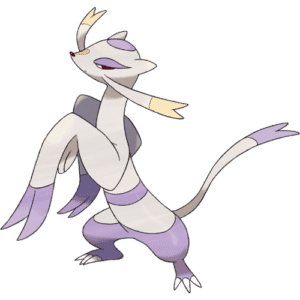
This one was a surprise to be sure, but Mienshao actually does extremely well in Regulation G. It has the Ability Inner Focus, which not only makes it immune to flinching from Fake Out, but also makes it immune to the Ability Intimidate. This makes it a prime Incineroar counter, able to knock it out with Close Combat. It can also utilize Fake Out very effectively.
However, the took that makes Mienshao so valuable in this format is its access to Wide Guard. As you can probably tell from the section on the new Restricted Legendary Pokémon, there are a lot of powerful spread moves being thrown around. Wide Guard protects both the user and its partner from these attacks. Many other Pokémon that have rarely seen play are seeing some usage on the basis of having access to Wide Guard alone, such as Hitmontop and Swampert. However, out of all the Wide Guard users, Mienshao is the most effective. It has a surprisingly wide array of tools it can use, so this long cat should not be underestimated!
Ogerpon (Cornerstone Mask)
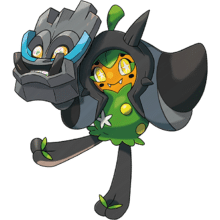
Ogerpon’s Cornerstone Mask Form was never bad, per se, but it was definitely outshined by the othe forms. However, Ogerpon-Rock has seen some more considerable usage stats going into Regulation G. Redirection is extremely helpful in the Single Restricted Legendary format, as your team often revolves around setting up your super powerful Legendary to sweep. Ogerpon’s Sturdy Ability in its base form ensures that it can live a hit, something that is more prevalent as the power level of the format has definitely increased. It’s 100% accurate Rock type Ivy Cudgel is a powerful tool that’s value has largely been overlooked. Especially with the prevalence of new threats such as Calyrex-Ice, as well as returning threats like Incineroar and Tornadus-I, and its no surprise that Ogerpon-Rock has seen some newfound success!
Walking Wake
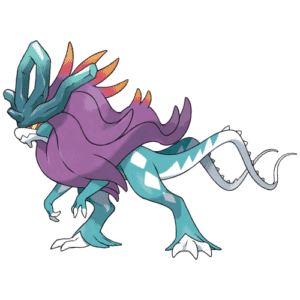
Walking Wake was never bad, but it definitely felt like there was a missing piece. It isn’t able to operate as effectively outside of Harsh Sunlight like the other members of the trio, Gouging Fire and Raging Bolt, are able to. It is strong to be sure, but it definitely needs a boost to both its Special Attack and Speed. Booster Energy alone wasn’t enough to make this happen, and its noticeable lack of spread moves makes it vulnerable to double ups in VGC. However, it is now able to be paired with powerful offensive threats like Groudon or Koraidon, who can exert some pressure themselves while also passively supporting Walking Wake. With the Harsh Sunlight up, Walking Wake can EV to get a Speed boost from Protosynthesis, then use the Life Orb item to increase its damage output. With the combination of Hydro Steam, its signature Water move that gets stronger in Harsh Sunlight rather than weaker, with Draco Meteor and Flamethrower have demonstrated the full potential that this Pokémon has been hiding!
Venusaur
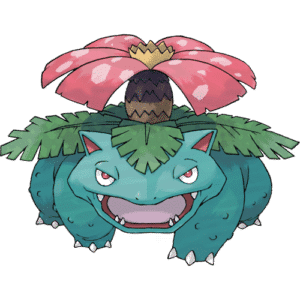
Venusaur may seem like an odd pick, but it is one of the most powerful starters when paired up with certain Legendary Pokémon. Venusaur’s Hidden Ability, Chlorophyll, doubles its Speed when under Harsh Sunlight, allowing Venusaur to act as an effective sweeper while also providing some utility with blazing fast Sleep Powder. It is especially effective when paired with Groudon, providing great bulky support and even having some nice coverage options with Fire type Weather Ball or Earth Power alongside STAB options like Energy Ball and Sludge Bomb. Similarly to Walking Wake, having more threatening Harsh Sun setters has increased Venusaur’s viability for sure!
Indeedee
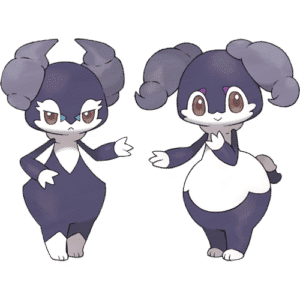
Indeedee has never been bad. In fact, it has been a staple in VGC since its introduction thanks to the amazing utility that Psychic Surge provides. It is still the only legal user of this Ability, and it made its claim to fame as a great support Pokémon/redirector on Psyspam teams. With the introduction of the Restricted Legendary Pokémon, Indeedee may have reached its full potential paired with its new best friend Calyrex Shadow Rider. The Psychic Terrain support allows Calyrex-Shadow to fire off STAB Expanding Force while being protected by Sucker Punches by Psychic Terrain and all other threatening incoming damage from Indeedee’s Follow Me. As one of only 3 passive terrain setters in the format, Indeedee is likely here to stay for the remainder of Scarlet Violet VGC.
Fallen From Grace
Flutter Mane
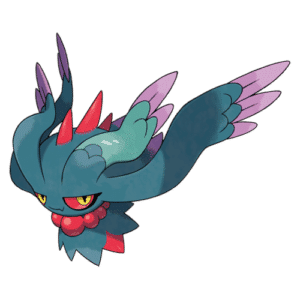
Ok, hear me out. I know this seems blasphemous, as Flutter Mane is still present on about 1/3 of all teams based on current usage stats. However, for Flutter Mane this is surprisingly low. Prior to Regulation G, Flutter Mane was a powerful offensive threat that could fit on pretty much any team and could sweep under many different conditions. However, Flutter Mane has some steep competition in Calyrex-Shadow. Calyrex is naturally faster than Flutter Mane and can outspeed and one-shot it with Astral Barrage. In order to even have a chance at winning, Flutter Mane needs to either use the Booster Energy to outspeed Calyrex or the Focus Sash to survive a hit, and both of these builds lose to Calyrex if it is also holding a Focus Sash. That combined with poor matchups against other popular Restricted Legendaries such as Terapagos and Zamazenta have cause this drop in usage.
Flutter Mane is far from bad, though. We weren’t getting rid of this thing that easily, this is just the first time that we’ve really needed to adjust the way we use Flutter Mane. It makes a great partner for Groudon and Koraidon, so almost no Flutter Mane are running Booster Energy anymore. This allows them to use Items to help it survive, such as Focus Sash or Safety Goggles, much more effectively. Flutter Mane has seen the best usage as a fast supporting Pokémon, opting for supporting moves like Icy Wind, Taunt, Trick Room/Imprison, and even Perish Song as a last ditch win condition. It still hits extremely hard with Moonblast and Shadow Ball, there are too many problematic matchups in the current meta for it to act as effectively as a sweeper as it has in the past. While it isn’t bad by any means, this is certainly a fall from grace for Flutter Mane to be sure.
Dragonite/Entei
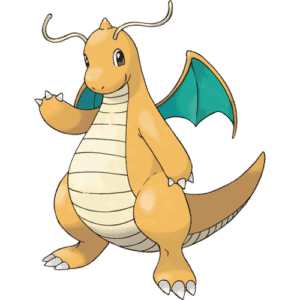
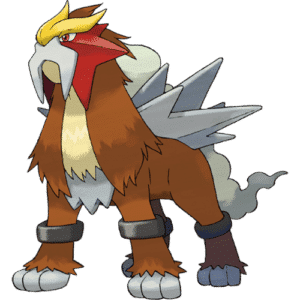
I’m lumping these two together based on their shared primary strategy. There are other sets that have been effective on these two, especially Entei, but they are most famous for their combination of the Inner Focus Ability, Tera Normal, and Extreme Speed. However, Rayquaza has entered the ring as a powerful alternative that is largely outshining these two options. Entei as of recently have been opting for a more flexible set using the Assault Vest, but this sacrifices some of the damage output of the Choice Band set. Dragonite still usually defaults to the Choice Band set, which is far from flexible and is extremely predictable. Rayquaza is able to deal crazy levels of damage with Extreme Speed and Dragon Ascent even without a boost, using a Clear Amulet in lieu of Inner Focus. However, if it gets a Swords Dance off, it is easily outshining these former staples. It has the flexibility and the power to have nearly drowned these two out of usage, at least in terms of the Extreme Speed spam. Entei is seeing much more usage with its Assault Vest set, but Dragonite is having an extremely rough time measuring up against Rayquaza.
Conclusion (kinda)
So sorry for the dissertation paper I seem to have compiled again. Who would have thought that introducing a whole cast of Legendary Pokémon would change the game so drastically? (this is sarcasm). As per usual, stick around if you want to see the team I used (to hit top 100 in the world this time!), but otherwise I’ll see you in the next entry!
The Team
Thank you to those who chose to stick around!
This season was a bit interesting for me in that I had been preparing for it far before the new Regulation dropped, which is different to how I approach these seasons. If i’m being honest, Regulation F never really clicked for me. I basically scrounged together a team to hit Master Ball tier, then never touched it again.
On Pokémon Showdown, a fan created online battle simulator, Trainers were able to practice the Regulation G ruleset prior to the launch of the in-game ladder. Because I didn’t personally care for Regulation F, I started experimenting with some of the new Restricted Legendaries early, so I was ready with a team when the in-game ladder dropped at midnight on May 1st. As such, I was one of the first players in the world to reach Master Ball tier, hitting rank 445 right off the bat!
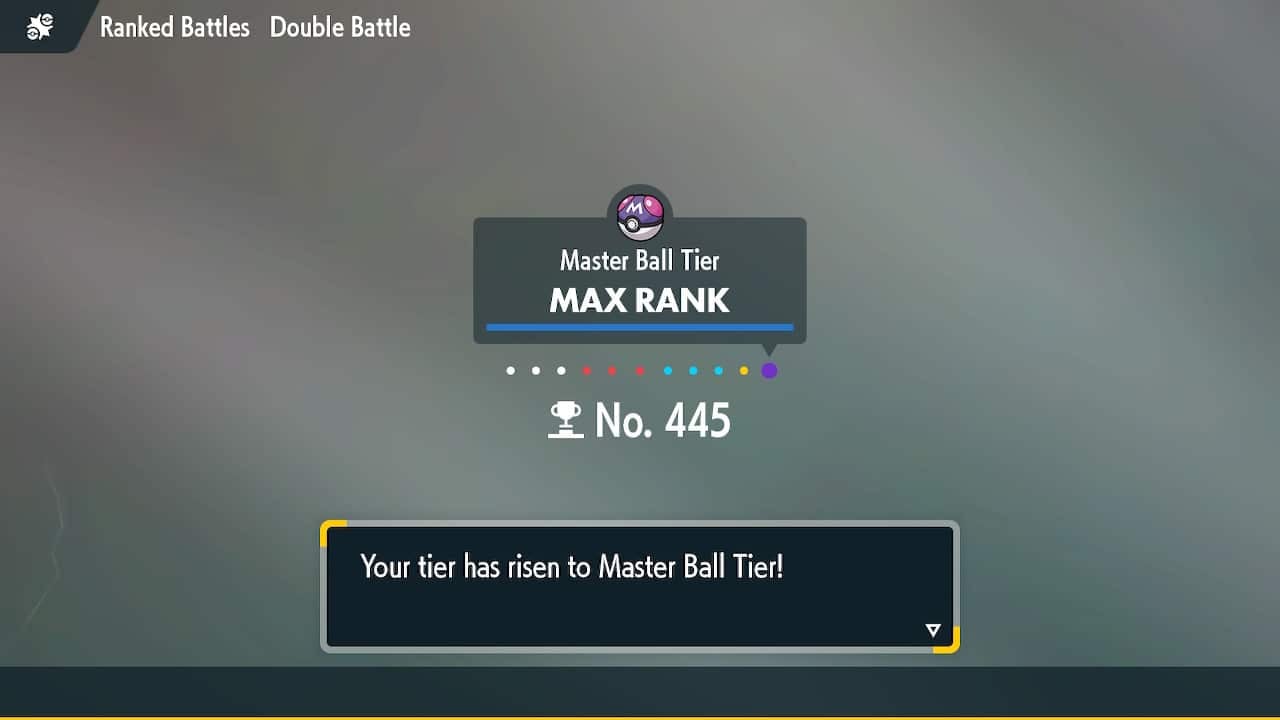
Once I hit Master Ball (at 3AM…), I did my best to continue competing, with my peak rank hitting number 74 in the world!

Of course, this was just a result of playing on release night. My rank eventually plateaued between 200 and 500.
As of writing this article, I haven’t played on the ladder in a few weeks. As such, the meta has likely evolved and my team likely wouldn’t perform as well. Additionally, I am far from an expert when it comes to teambuilding. However, it’s not like this team is completely useless, and I think that talking through my team will demonstrate some unique aspects of team building in this single Restricted Legendary format. With that being said, let’s take a look at the team!
Terapagos
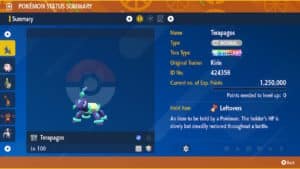
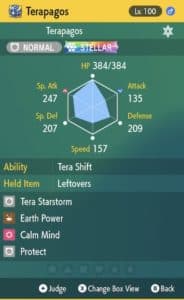
As mentioned earlier, Regulation G teambuilding pretty much always has to start with the Restricted Legendary Pokémon that you want to use, and the rest of the team will be built around it. For me, that was Terapagos. Having a signature move that hits both targets and cannot be resisted by any Pokémon in the game sounded extremely appealing to me, and it definitely didn’t disappoint! There was definitely a learning curve to using Terapagos, but having had time to practice before the official release, I was able to hit the ground running and surprise some of my opponents!
I used what was considered the standard Terapagos set. As a reminder, this set is probably outdated by now, as plenty of counterplay has been developed. However, I found it to be the best way to learn how to use Terapagos. Its Ability Tera Shell, as mentioned in Terapagos’s section, is extremely useful in helping Terapagos to set up at least one Calm Mind before Terastalizing and firing off powerful Tera Starstorms. With the combination of Leftovers and Protect, you can often manage to get multiple uses out of Tera Shell, allowing Terapagos to survive hits it has no business living and setting up even more Calm Minds. Earth Power provides some nice coverage to threaten some of the most prominent threats such as Incineroar. Terapagos can only ever be the Stellar Tera type, meaning it maintains the defensive profile of a Normal type, but this isn’t necessarily a bad thing in the current meta. As we’ll touch upon later, many of the other Pokémon on the team are designed to help cover Terapagos’s weaknesses.
Once you have mastered Terapagos’s multiple forms and Abilities, it can be extremely threatening. The one thing I will say is that the standard Terapagos set is extremely predictable. The team is relying almost entirely on Terapagos getting set up and sweeping through the team, so if it goes down you’re in trouble. More skilled VGC Trainers have developed new ways of using Terapagos that are more effective, but I was able to use the standard set to pretty decent success for myself. That being said, Terapagos cannot operate without heavy support from its team, so let’s take a look at the other Pokémon that can help set Terapagos up for success!
Clefairy
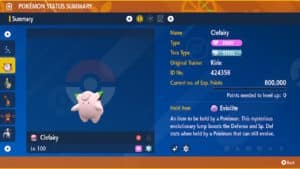
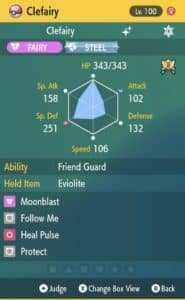
For those unfamiliar with VGC, Clefairy may seem like a ludicrous pick. However, it is one of the best supporting Pokémon in the game, and it pairs extremely well with Terapagos!
While Clefable is the obvious choice on paper, Clefairy has a few things going for it that make it much more viable than its evolution. First of all, it isn’t fully evolved, meaning it can make use of the Eviolite Item, which increases the defensive stats of a Pokémon that can evolve further. It also has the Ability Friend Guard, which reduces incoming damage against the user’s partner. These tools are both unavailable to Clefable and suit the role that Clefairy plays much better.
Redirection is extremely powerful in VGC, and the Clefairy line is one of the few to gain access to Follow Me, the best version of redirection in the game. Thanks to the right EV spread and the Eviolite, Clefairy is able to tank hits that it has no business surviving. It will likely live anything that is not a single target, Super Effective move. Having access to Follow Me allows you to play mind games with your opponent. Moves meant to take out Terapagos can be redirected into Clefairy, namely the Fighting type moves that would be Super Effective against Terapagos but are Not Very Effective against Clefairy. However, Clefairy can also let Terapagos take the hit, which it will likely survive thanks to Tera Shell and Friend Guard, and can instead use Heal Pulse to restore 50% of Terapagos’s HP! This is one of the many ways that you can use this team to get multiple uses out of Terapagos’s Tera Shell, allowing it to set up as many Calm Minds as possible before Terastalizing.
Clefairy’s Tera type is Steel, helping it survive hits from the two types that can hit it for Super Effective damage. However, this team largely revolves around Terapagos Terastalizing and sweeping through the opposing team, so Clefairy is almost never Terastalizing. You will see that this is a common theme for the rest of the team as well, but having the option to change up its type matchups defensively is nice to have as a plan B if Terapagos goes down early.
I just love the sight of Clefairy facing down the likes of Calyrex and Groudon, taking their extremely powerful attacks with ease. There may be room for some optimization with Clefairy, but for the most part I am never disappointed to have it on the field next to Terapagos!
Sinistcha
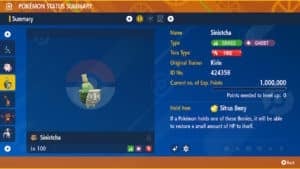
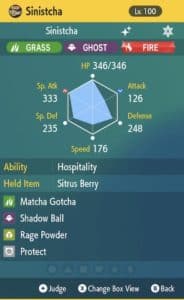
Next up we have Sinistcha, another powerful ally to help support Terapagos. Sinistcha has an insanely powerful signature Ability, called Hospitality, that make it an incredible utility Pokémon. Hospitality restores 25% of the user’s partner’s HP whenever Sinistcha switches in. Many Pokémon hold the Sitrus Berry Item for a single-use restoration of 25% HP, and Sinistcha can theoretically give this healing to its partner an unlimited number of times! This Ability is primary reason that Sinistcha caught my eye for the team. After Terapagos has set up a Calm Mind on turn 1 and has likely tanked a hit thanks to Tera Shell, Sinistcha can switch in next to it and heal it back up, potentially letting you get a second use out of Tera Shell and set up a second Calm Mind. I found that Terapagos with 2 Calm Mind boosts is near unstoppable, and Sinistcha is one of the best support Pokémon to help make this happen!
What’s more, Sinistcha can also help support Terapagos through redirection! Sinistcha is able to learn Rage Powder, which will redirect moves from all Pokémon except Grass types and Pokémon holding the Safety Goggles Item. While this doesn’t have the ability to protect Terapagos from everything like Clefairy with Follow Me does, it does completely negate any damage from incoming Fighting type moves, and it matches up extremely well against Kyogre and Urshifu Rapid Strikes. While Clefairy is better as a redirector and supporting Pokémon overall, Sinistcha excels in certain problematic matchups, making it valuable depending on the opposing team.
Sinistcha is trained with maximum HP and Special Attack. The HP helps it tank hits when using Rage Powder, and the Sitrus Berry gives it an extra burst of HP, as it is usually living a hit. For even more recovery, it can use its signature move Matcha Gotcha, which deals damage to both opponents, heals Sinistcha based on the damage dealt, and has the additional bonus of having a chance to Burn one or both of the targets! I initially had Strength Sap as the fourth move (Protect is a must), but I found myself never using it, as I had enough recovery options and a much more… intimidating way of lowering the opponent’s Attack stat. Shadow Ball was a much better option. Sinistcha hits the field and appears to be playing a support role, but Shadow Ball deals great damage to both Calyrex forms, which are the most popular Restricted Legendaries in the format.
Sinistcha’s Tera type is Fire, but again, this is almost never being used. I think that Tera Water might be more effective for what Sinistcha usually aims to do, but this option is used so rarely that I don’t think it will change how the team operates.
Sinistcha is primarily on the team for its support/utility tools to support Terapagos, but it is capable of dishing out some decent damage itself. The recovery from Hospitality is extremely valuable, and I find myself able to use it multiple times per battle without much difficulty. Additionally, it’s pretty infuriating for my opponents to have to contend with two different forms of redirection, which is always a plus. This little teacup can do it all!
Farigiraf
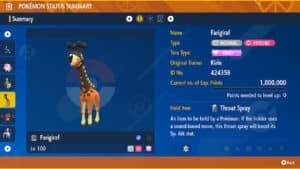
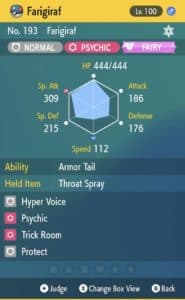
Those of you who read the previous article in the series on Regulation F may be familiar with this guy. It’s actually the exact same Farigiraf from the other team, with only a single change to its moveset. However, I’m once again getting ahead of myself.
Farigiraf’s signature Ability, Armor Tail, is able to protect your entire team from any moves with increased priority from the other team. Of course this blocks moves like Extreme Speed and Aqua Jet, but it also protects your team from the ever prevalent Fake Out, as well as any moves boosted by Prankster. Tornadus is still everywhere, and Taunt is Terapagos’s worst enemy, but a simple switch into Farigiraf can block any number of moves sent its way!
Farigiraf’s most useful attribute is its Ability, which operates almost entirely separate from its moveset. As such, I didn’t see much reason to change the way I was using Farigiraf, as I was already comfortable with it. Farigiraf can use Trick Room to help Terapagos sweep through teams that are built around speed, as it isn’t extremely fast, or to reverse it against dedicated Trick Room teams. The reason I am using the same Farigiraf as last season is because it has a 0 IV in Speed, allowing it to usually be the first Pokémon to move under Trick Room, and the combination of Hyper Voice and Throat Spray allows Farigiraf to deal solid damage.
The one change I made to the team was replacing Imprison with Psychic. Imprision was poweful in the right scenario, able to prevent the opponent from using Trick Room or Protect, but it was very situational. Wide Guard is extremely popular to protect against the various spread moves in the format, and I had found myself in positions where Farigiraf was pretty much useless, as this move also blocks Hyper Voice. Psychic gives me a powerful single target move that is even stronger if I’m able to activate the Throat Spray beforehand, and it has been much more useful overall.
Farigiraf is literally just here to block priority moves. While many of the new Restricted Legendary Pokémon don’t use priority moves, Fake Out and Prankster are still as wide spread as ever, and the ability to block these moves simply by having Farigiraf on the field is just as helpful as ever. Even though Farigiraf has been legal in every format in Scarlet and Violet, I still find myself able to position my team favorably as my opponent fires off a priority move only to be blocked by the funny giraffe. The more VGC I play, the more fond I grow of Farigiraf!
Incineroar
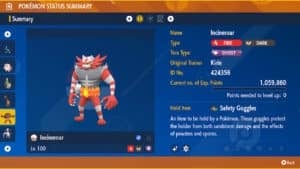
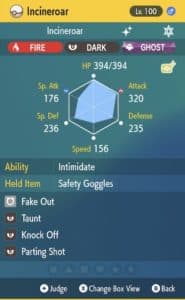
When in doubt, add Incineroar to your team. It is the best Pokémon in VGC, and its bag of tricks is so effective that it can more than hold its own against these powerful Legendary Pokémon.
I started off the season with an Assault Vest set to help Incineroar have the best chance of surviving any hit sent its way, as Intimidate is able to cover the physical side. As such, the moveset was Fake Out, Flare Blitz, Knock Off, and U-Turn. I had a Tera type of Grass, which turns it into an ideal Amoongus/Brute Bonnet counter and shuts off some of Incineroar’s biggest type weaknesses. However, I found myself struggling to use it effectively. This set would require Incineroar to Terastalize in order to do the primary thing I had it on the team to do, and as mentioned, I usually need to save my Terastalization for Terapagos. I knew I needed to make some adjustments.
I changed its Tera type to Ghost, which helps in matchups where Terapagos goes down early. It makes Incineroar immune to opposing Fake Out, as well as any Fighting type move sent its way. I changed the item to Safety Goggles to maintain my Spore immunity, and I replaced U-Turn with Parting Shot as I was no longer limited to attacking moves. However, I found myself still struggling, as this set was still useless if the the Spore user Terastalized itself. Fake Out and Parting Shot are essential, and Knock Off is useful in so many different situations, so I decided to drop Flare Blitz for Taunt. I usually lead off the battle with Incineroar next to Terapagos, so If I find myself against something that wants to put my team to sleep, I can use Protect with Terapagos and use Taunt on the mushroom, completely neutralizing both the threat of Spore or Rage Powder. From there, I can pivot out with Parting Shot into the next supporting Pokémon.
The one optimization left to make for Incineroar is its EV spread and nature. The change from Flare Blitz to Taunt is the most recent change I made to the team. I had a lot of investment into Attack with both EV’s and the nature so that Incineroar could have some offensive pressure, but this is pretty much gone without Flare Blitz, so some more investment into Speed or bulk would likely be more optimal. At the end of the day, though, Incineroar is still an absolute menace. It only makes sense that the best supporting Pokémon in the game would make the roster.
Mienshao
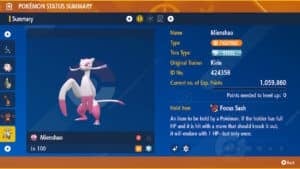
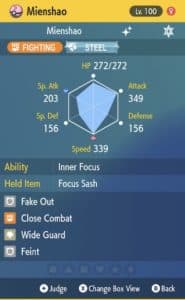
This last slot was tough for me to fill. I tried a lot of different options, using a Choice Scarf Urshifu Rapid Strikes for a while to try and give myself some sort of other offensive pressure other than Terapagos. However, I eventually realized that Mienshao was the way to go.
Mienshao has a surprisingly amazing set of tools that make it an amazing pick right now. It is able to completely counter Incineroar, being immune to flinching and Intimidate thanks to Inner Focus. Because of this, it can hit Incineroar with a full power Close Combat that it can’t stop from hitting with any of the tools the stupid cat usually uses. Additionally, you’re never upset to have another Fake Out user on your team.
However, it is Mienshao’s access to Wide Guard that makes it so valuable. Most of the most popular Restricted Legendaries right now use spread moves, including but not limited to Kyogre, Groudon, Both Calyrex forms, and Terapagos, as well as other popular moves such as Bleakwind Storm, Hyper Voice, Heat Wave, and more. If the opponent targets it with a powerful single target move, the Focus Sash allows it to live the hit, letting it use Wide Guard one more time before going down. Even just having Wide Guard on your team will make your opponent think twice before clicking a spread move, which can help Terapagos survive for the turn it needs to set up. I rounded out the moveset with Feint, which is niche but can be useful to break an opponent’s Protect for the turn to pick up a crucial KO. Its Tera type is Steel, the best type to help out Mienshao defensively, but again this is rarely used.
Mienshao was a very recent addition to the team, and in all honesty I am still figuring out how to use it. However, it has definitely won me some tough matches that I would have lost otherwise, and I’m sure that it will only become more valuable with time.
Team Usage
In case it wasn’t blatantly obvious from the team composition (or the numerous times I’ve outright said it), this team is built to support Terapagos. The strategy is to get 1 or 2 Calm Minds set up before Terastalizing and sweeping. The rotation of supporting Pokémon will change based on the matchup, but I usually default to Incineroar, one of the redirectors (depending on the biggest threats on the opposing team), and Farigiraf. In matchups where the opponents have no priority moves, then Farigiraf is replaced by the second redirector. Mienshao is primarily coming to the battle when there is a Calyrex-Ice on the other team, although it is helpful in other matchups as well. Like I said, I’m still figuring out how to use it most effectively.
Terapagos is always starting off the battle on the field to give it the most opportunities to get set up. Incineroar is usually the lead, as it is the best into the most different matchups. Additionally, the passive benefits of Clefairy, Sinistcha, and Farigiraf can be activated by hard switching Incineroar out. Leading with anything other than these two against an opponent who leads with Spore is pretty much an instant loss, and the other matchups can be dealt with by switching. If I see a Fake Out or a Prankster Taunt coming, then Farigiraf switches in. If I think they are going to double target Terapagos, I can switch in Clefairy to mitigate the damage. One of my favorite strategies is to use Calm Mind on turn one with Terapagos, pivot out with Parting Shot with Incineroar, and switch in Sinistcha to heal it back to full.
Getting the maximum usage out of Tera Shell is the best way to guarantee that Terapagos can get set up. The best way to do this is to recognize what Pokémon have tools that can prevent Terapagos from setting up, and choosing your support Pokémon to counter them. For example, if there are no Pokémon that commonly run priority moves, Fake Out, or have Prankster, then you might not need to bring Farigiraf. If there are no Grass types on the opposing team, then you can probably opt for Sinistcha instead of of Clefairy. If there are no spread moves, then there’s no need for Mienshao. This is probably the biggest learning curve for the team, and even after a good amount of time using the team I occasionally find myself in a spot where I’m picked the wrong supporting Pokémon for the matchup.
Terapagos has an extremely positive matchup against Calyrex-Shadow, and it can have great matchups against Kyogre, Groudon, and Miraidon with support from Sinistcha. The most problematic matchups for Terapagos are Zamazenta, Calyrex-Ice, and Koraidon. Out of these three, I personally struggle the most against Zamazenta. My best option against it is using Sinistcha to redirect its otherwise Super Effective Body Press. However, many Zamazenta are opting for Tera Grass, which shuts this down. Against Calyrex-Ice, Mienshao and Incineroar help make this matchup much more bearable, but a smart Calyrex-Ice Trainer can still make this difficult. Koraidon can effectively be dealt with using redirection, and Clefairy is usually the best for this. However, Terapagos will always lose a 1v1 against Koraidon’s Fighting moves.
At the end of the day, a single Restricted Legendary format ends up being a bit of a rock-paper-scissors type of meta, as every legend matches up well into some but poorly against others. The best piece of advice I can give for using this team would be to not overthink it too much in favorable matchups, and to learn which supporting Pokémon are the most effective in the unfavorable ones.
Conclusion
One of these days I’ll learn how to keep my thoughts concise, but that day is not today, as I think this article is the longest one in the series so far. I genuinely appreciate those of you who have stuck around this far. Regulation G has been my favorite format so far for a multitude of reasons, and I’m grateful y’all have given me a platform to share my thoughts. I’ll see you all in the next entry!










